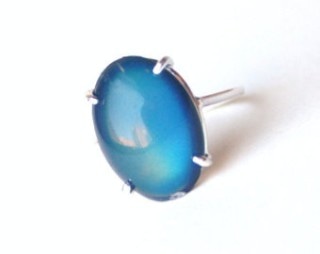May 12 2017
Liquid crystals are used not only for producing mood rings, smart glass and transitional lenses but also cell membranes, mucus and slug slime. At present, a research team is attempting to achieve an in-depth knowledge of the way in which liquid crystals, when integrated with bacteria, form living materials and the manner in which they interact with the bacteria to organize and move.
 Mood rings, mucus, and slug slime: What do they all have in common? CREDIT: clipartfest.
Mood rings, mucus, and slug slime: What do they all have in common? CREDIT: clipartfest.
One of the ideas we came up with was materials that live. Living matter, active matter may be self-healing and shape-changing and will convert energy to mechanical motion.
Igor S. Aronson, Professor of Biomedical Engineering, Chemistry and Mathematics at Penn State University
The living material Aronson is exploring using predictive computational models and experiments is comprised of bacterium called Bacillus subtilis as well as a nematic liquid crystal, called disodium cromoglycate. The long flagella of the bacterium enable it to move quickly. As materials, liquid crystals are positioned between a solid and a liquid. Here, the molecules of disodium cromoglycate are arranged in long parallel rows but are not fixed in their positions. With the ability to move, the molecules continue to be oriented in a single direction until they are disturbed.
This kind of liquid crystal looks very similar to a straight-plowed field in which the molecules are the ridges and the areas in between are the furrows, says Aronson.
Earlier the research team discovered that the tiny bacteria inside the liquid crystal material have the ability to force cargo (i.e. tiny particles) through the liquid crystal’s channels. They travel at four times the length of their body while existing in small concentrations. However, when they exist in large concentrations, they travel at 20 times the length of their body.
Movie Cargo transport
Bacteria on the left in illuminated circle moves through channel towards particle. When it reaches the particle, it increases speed and moves the particle away. (Aronson Lab / Penn State)
An emergent property of the combination of a liquid crystal and bacteria is that at about a 0.1 percent-by-volume bacterial concentration we start to see a collective response from the bacteria.
Igor S. Aronson, Professor of Biomedical Engineering, Chemistry and Mathematics at Penn State University
This kind of living material is not just a combination of two components. In contrast, the two components generate a material with exceptional electrical, physical and optical characteristics. Yet, there is no direct link between the liquid and the bacteria.
The computer models developed by the researchers exhibited collective behavior in their system, similar to that of real liquid crystal and bacteria combinations.
The predictive computational models developed for the liquid-crystal bacteria system indicate an alteration from straight parallel channels for small bacteria concentrations to an organized, more complex, active configuration for higher bacteria concentrations. Although the patterns are ever-changing, they develop pointer defects (arrow shapes) acting as traps and helping in the accumulation of bacteria in one specific area, as well as triangle defects that drive the bacteria away from that area. When the concentration of bacteria is high, the bacteria’s velocity and the configurations in areas with greater bacteria concentration get altered more quickly, when compared to areas with a lesser bacteria concentration.
Aronson and his colleagues looked at actual liquid-crystal living materials in a somewhat different manner than they did previously. The researchers didn’t want the liquid-crystal thin film to be in contact with any surface. To achieve this, they employed a device that formed the film (in a manner similar to the one used to develop large soap bubbles) and hung it at a distance from surface contact. This technique revealed the defect patterns in the structure of the material.
The researchers stated that the experiments involving thin films formed of liquid crystals and bacteria generated results similar to that provided by computational models.
The researchers discovered yet another effect, that is, when oxygen in the system was eliminated, the activity of the living material was terminated. Bacillus subtilis is commonly found in environments with oxygen. However, it can also withstand in domains that do not have oxygen. In contrast to being perished due to lack of oxygen, the bacteria in the living material just stopped moving until the supply of oxygen resumed.
Findings suggest novel approaches for trapping and transport of bacteria and synthetic swimmers in anisotropic liquids and extend a scope of tools to control and manipulate microscopic objects in active matter.
Research Team, Physical Review X
Since specific biological substances such as cell membranes and mucus at times exist as liquid crystals, the study might provide not only an in-depth understanding of the ways in which the biological substances react with the bacteria, but also knowledge on diseases caused as a result of bacterial penetration into mucus.
Mikhail M. Genkin, Doctoral Student in Engineering Science and Applied Mathematics from the Northwestern University; Andrey Sokolov, Materials Scientist at Argonne National Laboratory; and Oleg D. Lavrentovich, Trustees Research Professor in the Liquid Crystal Institute and Chemical Physics Interdisciplinary Program at Kent State University are the other co-authors of the study.
The study was supported by the U.S. Department of Energy.
comp model
Computer generated model on the top left shows the pattern created by the interaction of bacteria and a nematic liquid crystal. Areas form that concentrate bacteria while others funnel bacteria away creating an absence of bacteria. The image on the right shows the concentration difference of bacteria as the liquid crystal patterns change. Bottom left image shows the changing velocity of the bacteria and the bottom right image shows the changes in concentration of the bacteria. The more bacteria in an area, the faster they move. (Credit: Aronson's Lab, Penn State)